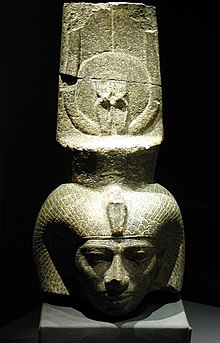Piye
He revitalized the moribund Great Temple of Amun at Jebel Barkal, which was first built under Thutmose III of the New Kingdom, employing numerous sculptors and stonemasons from Egypt.
In reaction to this, Tefnakht of Sais formed a coalition between the local kings of the Delta Region and enticed Piye's nominal ally—king Nimlot of Hermopolis—to defect to his side.
Tefnakht then sent his coalition army south and besieged Herakleopolis where its king Peftjauawybast and the local Nubian commanders appealed to Piye for help.
Tefnakht took refuge in an island in the Delta and formally conceded defeat in a letter to the Nubian king but refused to personally pay homage to the Kushite ruler.
Despite Piye's successful campaign into the Delta, his authority only extended northward from Thebes up to the western desert oases and Herakleopolis where Peftjauawybast ruled as a Nubian vassal king.
[17] A dissenting opinion came from Olivier Perdu in 2002, who believes that this stela refers instead to the later king Tefnakht II because of stylistic similarities to another, dated to Year 2 of Necho I's reign.
[20]Piye's tomb was located next to the largest Pyramid in the cemetery, designated Ku.1 (seen in the image on the right), at el-Kurru near Jebel Barkal in what is now Northern Sudan.


